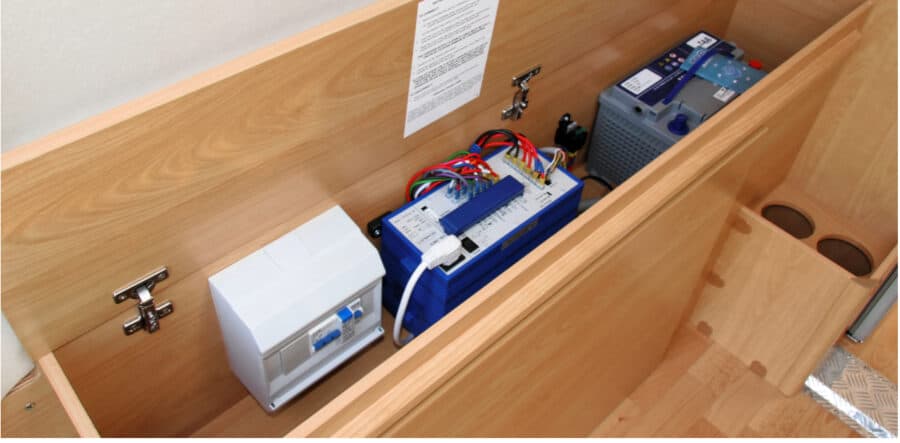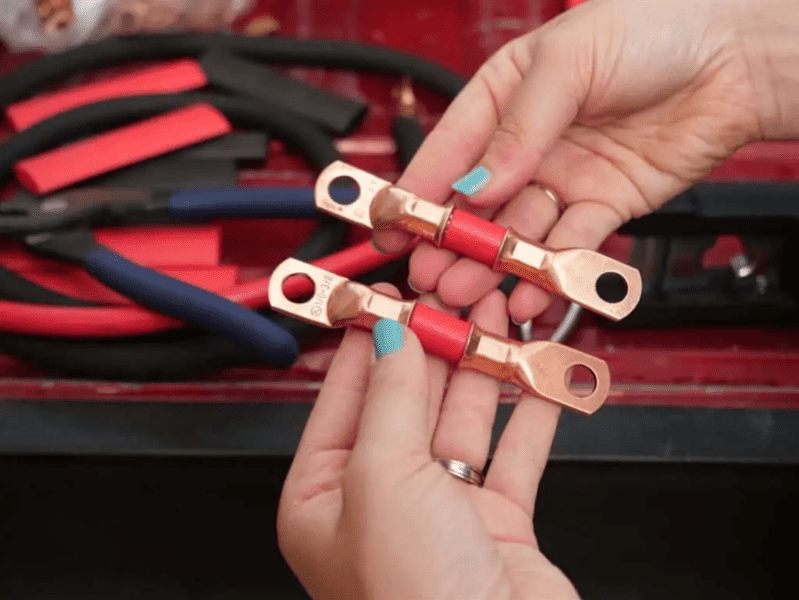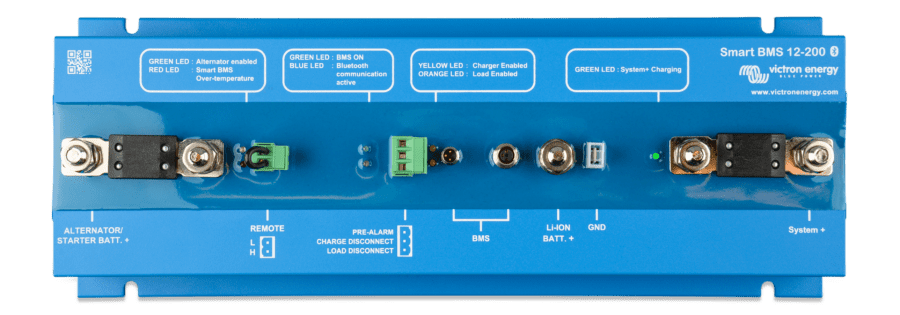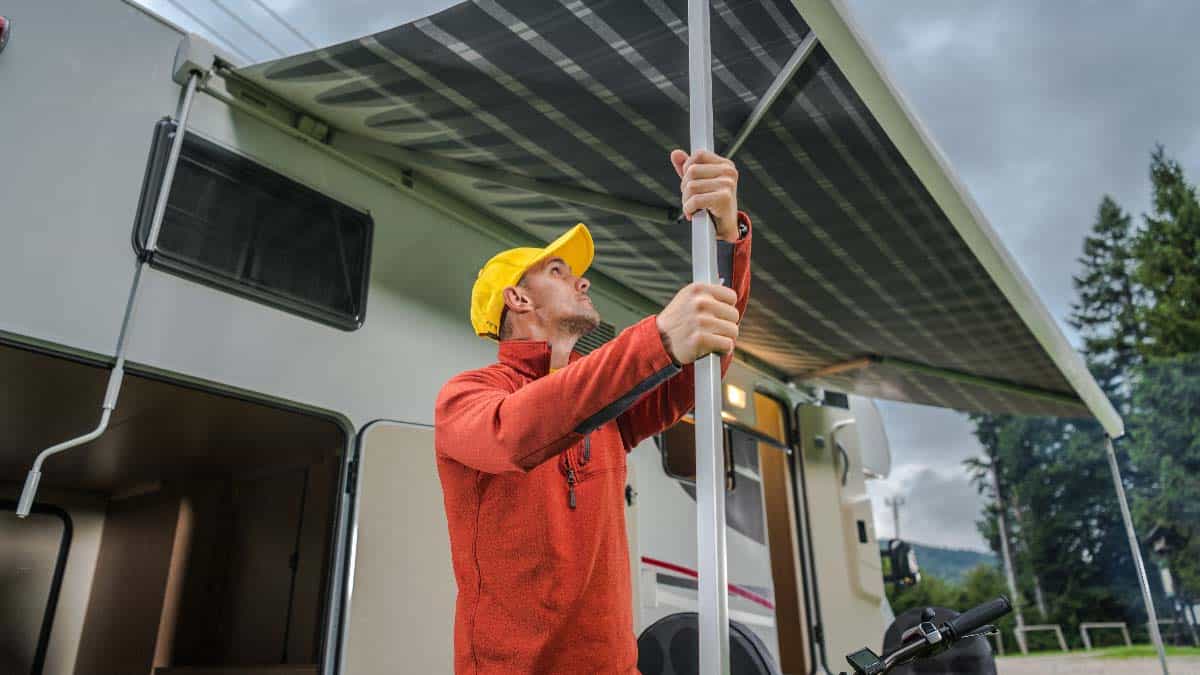There are some simple truths about installing lithium batteries in an RV that get buried by complexities and misinformation. Some may find it beneficial to convert their RV to lithium, while others may not. Whether you’re thinking about making the switch or just want to know the truth, our discussion about installing lithium batteries will clear things up.
You’ll learn about the benefits lithium batteries offer, the best place to install lithium-ion RV batteries, and the other components you’ll need to complete the project. We’ll also show you how those with 30-amp RVs can make the conversion over to lithium batteries without frying their electrical system.
In our discussion, we’ll mention the various electrical measurements like amps, amp-hours, volts, and watts. If you need a quick review of this electric jargon, check out Camper Report’s explanation.

10 Truths About Lithium Batteries in RVs
Before we start talking about the installation process, there are some simple truths we want to cover that prove lithium batteries are good for RVs. There’s a lot of information floating around and many different versions of lithium-ion batteries in the marketplace. Unfortunately, many people can’t talk about these batteries without broaching the subject of RV solar panel systems. So, let’s clear some things up:
- RV solar systems work best with lithium-ion batteries, but you can use lithium batteries without solar panels. Your RV generator, tow vehicle’s umbilical cord, or motorhome’s alternator can charge them just like the lead-acid batteries you currently use.
- The correct type of lithium battery uses lithium iron phosphate-oxide, not the ones with poisonous cobalt. The battery industry refers to them by their chemical abbreviation: LiFePO4.
- You can install lithium batteries for your house batteries, not your engine starting battery. Most RVs use the Group 27 battery size, but some will use Group 24, Group 29, or others. Your house batteries should be labeled. If not, check your owner’s manual, call your RV dealer or RV manufacturer.
- You can install lithium batteries on any RV that accepts house batteries. They use the same connections that lead-acid batteries have. In addition, LiFePO4 batteries for RVs have the exact dimensions as their lead-acid counterparts.
- The gelatinous substance lets you install lithium batteries sideways, upside-down, and inside your RV without ventilation. Lead-acid batteries contain water and must have ventilation to distribute harmful gasses.
- Once you install lithium batteries, you can use them in temperatures between -4° to 135° Fahrenheit (lead-acid caps off at 113°F). You can charge LiFePO4 batteries above freezing temperatures; they won’t accept a charge below 32°F.
- Lithium batteries are half the weight of lead-acid versions. Traditional RV house batteries have an average weight of 65 pounds. So if your RV has two 12-volt lead-acid batteries, you could increase your power capacity with four 12-volt lithium batteries without moving the scale.
- On the financial end, lithium batteries cost more at the point of sale, but they’re a better investment overall. The average lead-acid battery lasts around five years. LiFePO4 batteries can last decades. The COO of Battleborn Batteries, Sean Nichols stated “lithium-ion batteries are 30 cents cheaper per [recharge] cycle compared to lead-acid versions.”
- In most cases, installing lithium batteries is virtually “plug-and-play.” Many come with built-in battery management system (BMS) in the battery’s casing. In other words, under most conditions, they regulate themselves. However, we still recommend performing a visual check-in monthly.
- The general rule of thumb for lead-acid batteries is to charge them when they reach 50% of their energy capacity. Lithium-ion batteries can limbo lower. Some companies will label their batteries for a specific amp-hour rating, but have a bigger capacity, has a margin of error preventing complete power drainage.
What Size Lithium Battery Do I Need for my Travel Trailer?
You need to know some other simple truths to determine the lithium battery size you need for your travel trailer or motorhome. Most RVs on the road today use Group 27 batteries. Some of the Classic Era (1971-1989) or earlier may use Group 24, Group 29, or Group 31 versions. One of the few components to standardize in the RV industry by the late 20th century was the house battery.
Generally, RVers keep it easy by purchasing 100 amp-hour capacity batteries for two reasons:
- It makes calculating their total energy storage simple
- The battery industry makes more of them
Lithium-Ion batteries come in 12, 24, and 48-volt versions. You’ll find them with capacities between 50-500 Ah.
If you check your RV’s house battery bay, 50-amp RVs (ones with the 4-prong shoreline) have two 12-volt batteries. 30 amp travel trailers and motorhomes (3-prong electric cords) have two 6-volt batteries. Those with the higher amperage may feel they don’t have anything to worry about, but many 30-amp RVers may have concerns about installing lithium batteries.
Can 30-Amp RVs Use Lithium Batteries?
YES, 30-amp RVs can use lithium batteries. RV manufacturers install two 6-volt batteries as a precaution. If one goes bad, there’s another in place. From an electrical standpoint, installing a lithium battery rated at 12-volts is the same as two 6-volts.
Lithium-ion batteries are very hardy technology, so relying on one LiFePO4 battery is a safe bet. The best lithium-ion batteries have the BMS within the housing, acting as a monitor. If the battery becomes too cold or is too low on energy, the system will shut the battery down for safety.
How Do I Increase The Capacity of my RV Batteries?
Most RVers want to know how to increase the capacity of their RV batteries.
It’s been hard to find a campsite during the Remote Period of the Modern Era’s (2020- Present) RV boom. Dry camping has become a substitute for campgrounds and has its RV lifestyle advantages. Electric power can make long boondocking experiences more comfortable.
Installing lithium batteries in multiple sets increases your power needs for longer durations. To do this correctly, you must know how to connect the batteries in the proper configuration. There are two ways to do this: parallel or in a series. Using the wrong setup can damage the RV’s electric system to the point where you need to replace all required components.
Parallel Configuration
The positive and negative poles stay separated when installing lithium batteries in an RV in a parallel configuration. This means you connect positive to positive using the red battery cables and the black cables for the negatives. 30-amp RVs must use this configuration to maintain the 12-volt power level.
The advantage of a parallel setup is increasing the amp-hours. If each battery has 100 Ah and you have four LiFePO4 batteries, your RV now has a 400 Ah power capacity. Instead of existing with the bare minimum, you’ll have more power to use more electronic devices or camp longer without recharging.
Series Configuration
50-amp RVs that have high-powered electronics may find a series configuration beneficial when installing their lithium batteries. When you connect the positive pole to the negative pole and vice versa, you’re increasing the voltage output.
For example, if you have two 12-volt lithium batteries in a series configuration, you’ve increased the voltage to 24-volts. So, with the proper precautions, an electronic device that generally uses 30-amps at 12-volts could use 15-amps at 24-volts.
Bringing the amperage down on a high-amp device can save energy. If you want to do this, consult a professional electrician and the electronic device’s owner’s manual to determine if this benefit is possible on your RV. Generally, RVers use the parallel configuration because it’s lower risk.
How Many Lithium-Ion Batteries Do I Need for my RV?
To determine how many lithium-ion batteries you need for your RV, you have to think about your electrical needs. Every electronic device requires a certain amount of watts/amp-hours. Someone using a teardrop camper for the bare essentials may only need one 100Ah battery. A boondocking family hauling a 43-foot fifth-wheel who doesn’t want to count their watts may need eight so they don’t have to start up their generator.
To give you some perspective here’s a basic chart to help you start the conversation on finding the right amount of lithium-ion batteries you’ll need for your RV.
| # 100Ah Batteries Needed | Electrical Needs | RV Size |
| 1 | Charge mobile devices, Coffee maker, LED lights, Radio, Small fan | 10-14 ft. |
| 1 | Charge mobile devices, Charge tools, Fans, LED lights, Radio, Small cooking device, Small electric cooler | 10-14 ft. |
| 2 | Charge mobile devices, Coffee maker, Cooking device, Electric stove, Fans, LED lights, Medical device, Medium electric cooler/small fridge, Radio | 15-20 ft. |
| 2 | Charge mobile devices, Coffee maker, Cooking device, Electric stove, Fans, Large electric cooler/small fridge, LED lights, Medical device, Radio, Small TV | 21-30 ft. |
| 2-4 | Charge/use mobile devices, Coffee maker, Cooking device, Electric stove, Large Fans, Large LED TV, LED lights, Medical device, Medium fridge, Radio | 31-40 ft. |
| 4-8 | Air conditioning (400Ah+), Coffee maker, Cooking devices, Electric stove & oven, Large fridge, Large LED TVs, LED lights, Radio, Use mobile devices | 40+ ft. |
Do I Need To Change My RV Converter for Lithium Batteries?
You don’t need to change your RV converter for lithium batteries if you have an RV built in the Modern Era. When Yet-Ming Chiang and his M.I.T. researchers discovered the LiFePO4 compound in 2004, it didn’t take long for the battery and adjacent industries to adapt their technologies to the new power storage advancement.
Current RV converters have some type of switch that adjusts the programing from a lead-acid to a lithium-ion modality. Some AC to DC converters have an automatic equalizer that makes sure multiple lead-acid batteries charge evenly. If the auto equalization function doesn’t disable, replace the converter before installing lithium batteries.
When replacing the converter, make sure you keep it at the same amp level as the previous one. For example, if your current RV converter is 55-amps, purchase a new 55-amp with a lithium battery setting.
Battery Cables

If you’re connecting multiple lithium batteries, you’ll need the thick gauge red and black battery wires. These copper wires come in various sizes for different requirements. You’ll be using the cables to connect the batteries and other components.
The first way is to order spools of red and black cable, a hydraulic wire cutter, a hydraulic crimper tool, crimp ring terminals, and heat shrink tubes covering the connections. The tools and crimp rings do come in kits, but make sure they come in the correct gauge (AWG) you need.
A second option is to go to your local auto parts store and have them cut the wiring you need from their supply behind the counter. Of course, you’ll still need to crimp the rings on yourself, but a pair of pliers works just as well and some electrical tape covers the connections correctly.
It can save you some money, and you won’t have to worry about all that extra cable rattling around your storage bay. We do recommend having one or two extra cables cut for backup purposes. Also, get both red and black. You must differentiate the positive (red) and negative (black).
RV Inverter
For your RV uses AC power then you’ve probably used your gas generator when boondocking.
If you’re a resident of California, you may have heard about the California Generator Ban legislation that’s making news right now. If it passes, you won’t be allowed to use a portable gas generator or onboard RV generator in the state starting in 2028.
RV converters change the AC coming from your shore power cord and convert it into DC power. The DC power goes into your RV’s house batteries and operates your DC electronics. These items include your slide-outs, interior lights, power awning, and more.
Conversely, an RV inverter changes the DC power from the house batteries to AC electric for many of your needed amenities and creature comfort devices. This includes your air conditioners, TVs, appliances, water pump, and many other features.
When you add up all of the watts of the electronic devices you need, choose the RV inverter that’s the next level up. Having that “cushion” of extra wattage will keep your inverter from burning out. For example, if your total wattage totals 1,500 watts then purchase the 2,000-watt device.
Shunt Battery Monitor

We’ve recommended installing lithium batteries with built-in battery management systems, but having a shunt battery monitor is necessary. A Smart Shunt like Victron’s Lithium Battery System shows you information the BMS doesn’t and displays it conveniently wherever you want it.
A shunt monitor measures your lithium batteries’ voltage and current draw performance in real-time. It uses this information to show you how your batteries are operating. You can learn:
- How much power you have left in your battery bank
- The level of energy consumption the RV’s using right now
- A projection of the remaining power left at your present energy consumption level
There’s other information it displays. While the BMS gives you basic information about each battery, the shunt battery monitor looks at the overall system. Using a Smart Shunt allows you to connect via Bluetooth to your mobile device to see everything in greater detail. Victron’s display is a basic digital device that shows the readings individually. You can see how it all works together on your phone or tablet.
Can I Add Solar Panels to My Existing RV Electrical System?
Once you’ve installed lithium batteries and the peripherals into your RV, you can add solar panels to your existing system. While it’s a discussion for another time, we can say that the lithium battery installation we walked you through sets you up for an RV solar system.
Have you upgraded your RV by installing lithium batteries? How did it go? Share below in the comments.
For more RV-related content, sign up for the Camper Smarts newsletter that is published every Tuesday.





You did not mention the battery isolation manager (BIM). My understanding is that a BIM designed for liFePO4 batteries is necessary to safely charge those batteries from the alternator on the engine.
can you run a lithium battery in parallel with a AMG battery
Morning
My concern is that my alternator will see a short with Lithium batteries and run wide open. Don’t we need a shunt or isolator for alternator
Thanks
Jim Werner
My guess is having a 50 amp or 30 amp service RV has nothing to do with the battery you install. RVs are built with 12v DC and 120v AC systems. Ultimately you need 12 volts from 12v batteries or stepped down from 24 or 48v. 6v batteries in series is another option. 120v AC will come from an inverter powered by 12, 24 or 48v.
You say 50a RVs have 2 12v batteries. I think many have 4 6v ones in series/parallel configuration making 12v output. Then you say 6v batteries help, when one goes bad you have the other as backup. Actually they would be wired in series for the 12v of the RV. One goes bad you have nothing.
And direct charging lithium batteries from the engine alternator is problematic for more than one reason. The very low internal resistance of lithium batteries can lead to overheating of alternators and their premature failure. Also, engine alternators don’t produce the proper voltage for lithium batteries. A common solution to this problem is installing a DCDC converter.
No, don’t crimp your own cables with pliers. That is asking for trouble. Buy an inexpensive anvil-style crimper and use heat shrink tubing to finish it off. Joseph and James, to charge the LiFePO4 battery from the tow vehicle, you need an isolator, amp limiter, and higher voltage charging. An isolating DC/DC converter like Victron’s does all of that. Mine bumps up the voltage from to the LiFePO4 to 14.2 (or whatever you set it to) so that the battery can get fully charged. And it isolates if your vehicle doesn’t already have one, so your trailer won’t run down your car battery. And it limits current so you don’t have to worry about overtaxing your alternator.
If you connect two 12 volt batteries in series and create 24 volts, you can not connect this into a 12 volt system. You will fry every 12 volt component connected.
Good morning. I am considering changing my AMG batteries to lithium. Some one told me my wiring would not be heavy enough. I don’t think this is right I presently have two AMG batteries
Good report,
it looks like this batteries are not for use up hear in Canada, as they can not be charged if temperatur hits 32′ Fahrenheit there are not to many months we don’t get that temperatur.
If going south for winter I will have no battery power until I hit Nevada. I will have to keep the Battery I have now.
Any connection of lithium batteries to the alternator of the vehicle requires a charge management DC to DC converter (not an old style BIM) that has lithium profiles. Victron makes the Orion line. Other manufacturers have similar products. The device limits current draw as well as regulates charge profile. Need to know the size of the alternator and sort of chassis DC loads and “what’s left over” for the house batteries.
And no, lithiums cannot be combined with “non lithium” batteries…..and mixing lithiums is not good either as it becomes near impossible for the non-matching batteries to charge fully and actually top the cells.
Two 6volt batteries (typically in series) do not offer and redundancy, since if one cell goes dead the combined circuit is rendered open…
Joseph Novak, you should absolutely use a BIM when installing lithium batteries. There are instances of burning up $800 alternators on larger diesel rigs w/o the BIM. I installed a BIM Li-225 on mine. Available from Battleborn. (Not an endorsement).
James, never mix battery chemistry. Always use all AGMs or all Lithiums or all lead acid.
James M Werner, either a BIM isolator or a DC to DC charger is highly recommended to protect your alternator.
“can you run a lithium battery in parallel with a AMG battery”
This is not recommended because the charging cycles for the two types of batteries are different. AGM lead acid based batteries are charged using a three step charge cycle; bulk, absorption, float while LiFePO4 ones use a two step charge cycle of constant current then constant voltage. A three step AGM charger will charge the lithium batteries but should not bring them to full charge. It will bring them to 85-90% of full charge and possibly a little higher. Check the Battle Born web site for additional information.
————————————————————————————————–
“My concern is that my alternator will see a short with Lithium batteries and run wide open. Don’t we need a shunt or isolator for alternator”
Most 100AH LiFePO4 batteries can be charged at a rate of 1C. 1C is shorthand notation for one times the capacity of the battery. If you install two in parallel, they can absorb charge current at 200A which is probably higher than the maximum current output of your alternator. Alternators output their maximum current when the battery voltage is well below 12V. LiFePO4 batteries output voltage drops significantly below 12V only when they are almost fully discharged. Normal alternator output is between 13-14V which is below the voltage the lithium batteries use for the constant current and constant voltage charging voltages. This will decrease the charge rate of the lithium batteries.
Great article! I upgraded to 2 – 100 Amp Battle Born LiFePO4 batteries. My 2019 Reflection had the standard converter. I needed to change it out because it did not put out the proper 14.6 volts for my new batteries.
I personally would not use a pair of pliers to provide crimping for a cable that may carry 200 amps. High resistance connections from poorly crimped cables can cause very high temperatures and fires.
This is going to be great if you buy a RV that is originally set up for these. Otherwise too many possible problems. You need to move batteries from original location to somewhere in the RV basement so they can be charged at low temperatures for instance. Not ready to change yet.